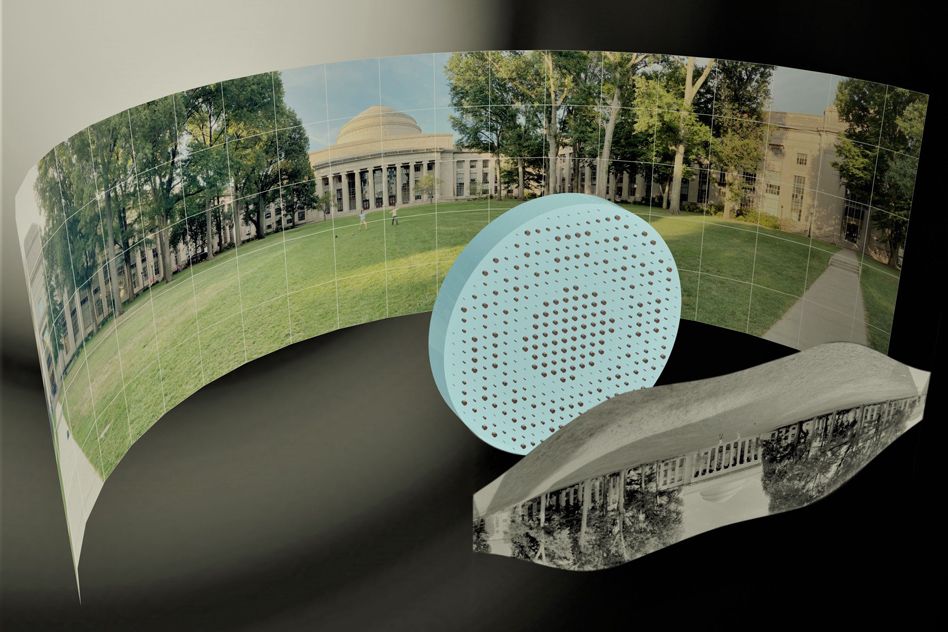The Weather Channel broadcasts tornado with Unreal Engine AR.



IS THE METAMATERIAL FISHEYE LENS AN ANSWER FOR RETINAL PROJECTION? There is a race to figure out the best way to project images onto the human retina, for augmented reality devices. Since the human retina is curved, unlike a photographic plate, a wide-angled, curved image designed to fit with the inherent curvature of the retina is in order. Planetariums can use fisheye lenses to project onto a curved dome in a similar way. Can modification of the new method for creating flat, wide angled fisheye metalenses be used for this purpose? There would be three immediate applications of such a capability: 1) Augmented reality projection which is not limited to a narrow portion of the visual field. 2) Full immersion virtual reality devices. 3) Night vision glasses that take large areas of aperture and project wide-angled images through a smaller exit pupil than the human pupil. It is possible that such a lens would be used in combination with another complementing metalens to allow the proper projection.
To capture panoramic views in a single shot, photographers typically use fisheye lenses — ultra-wide-angle lenses made from multiple pieces of curved glass, which distort incoming light to produce wide, bubble-like images. Their spherical, multipiece design makes fisheye lenses inherently bulky and often costly to produce.
Now engineers at MIT and the University of Massachusetts at Lowell have designed a wide-angle lens that is completely flat. It is the first flat fisheye lens to produce crisp, 180-degree panoramic images. The design is a type of “metalens,” a wafer-thin material patterned with microscopic features that work together to manipulate light in a specific way.
In this case, the new fisheye lens consists of a single flat, millimeter-thin piece of glass covered on one side with tiny structures that precisely scatter incoming light to produce panoramic images, just as a conventional curved, multielement fisheye lens assembly would. The lens works in the infrared part of the spectrum, but the researchers say it could be modified to capture images using visible light as well.

The US Army is testing augmented reality goggles on its service dogs in hopes to allow troops to give orders remotely.
Pooches are commonly deployed to sniff out explosives, hazardous materials or to assist in rescues. The tech would retrofit special safety goggles military dogs already wear with live cameras and visual indicators so handlers can issue specific directions – allowing the dogs to work without putting soldiers in danger.
“Augmented reality works differently for dogs than for humans,” said Dr. Stephen Lee, an Army Research Office senior scientist in a statement. “AR will be used to provide dogs with commands and cues; it’s not for the dog to interact with it like a human does. This new technology offers us a critical tool to better communicate with military working dogs.”

The US Army is developing augmented reality goggles for dogs to help protect their human guardians.
The BBC reports that the project, funded by the Small Business Innovation Research program, aims to allow soldiers to give dogs specific directional commands while they’re not in direct line of sight.
“Augmented reality works differently for dogs than for humans,” Stephen Lee, an Army Research Laboratory senior scientist, explained in a statement. “AR will be used to provide dogs with commands and cues; it’s not for the dog to interact with it like a human does.”

At this year’s #MSIgnite we revealed how HoloLens 2 is helping build the NASA’s Orion Spacecraft, designed to return astronauts to the moon and pave the way for human exploration to Mars.

Before #COVID19, we like to imagine a #future where we can get and do anything from home, including working, with the help of novel #technologies such as #VR and #AR.
However, the #COVID19 pandemic shows us the human nature, that is, “going out” is one of the basic needs for human being!
One revelation here is that: When speaking of how #technology can change our lives, we often neglect the humane factors and focus only on the technical ones. Take #VR as an example. Yes, it does allow you to have a shopping experience similar to (or even better than) shop outside. However, do you really want to stay at home 24/7 and complete everything online?
https://tek.io/2RP6LGn
by Esther Shein from TechRepublic
#WorkFromHome #FutureOfWork #RemoteWorking
Mental health was the No.1 factor influencing future working environments, the ongoing IBM Institute for Business Value survey found.


Inspirational speaker and Amazon best-selling author Sanjo Jendayi once said, “Listening doesn’t always equate to hearing. Hearing doesn’t always lead to understanding, but active listening helps each person truly ‘see’ the other.”
Jendayi was providing a little philosophical advice during a motivational speech, and technology was likely the last thing on her mind. But her words in fact might best describe the notion behind groundbreaking advances by the Facebook Reality Labs Research (FRLR) team’s top scientists, programmers and designers.
A post on the FRLR web site last week provided a peek into where the social media giant is heading in the world of augmented reality and virtual reality.

What do you think about this technology? Would you wear one?

Amanda Christensen, ideaXme guest contributor, fake news and deepfake researcher and Marketing Manager at Cubaka, interviews Dan Mapes, PhD, MBA co-founder of VERSES.io and co-author of The Spatial Web: How Web 3.0 Will Connect Humans, Machines, and AI to Transform the World.
Amanda Christensen Comments:
We’ve come a long way since the invention of the internet, and even further since the invention of the first computer, which together have undeniably significantly facilitated everyday life. We have never had access to more information at the touch of our fingers, or been more connected than we are now.
However, the exponential advancement of the internet has brought along with it a whole host of problems, such as the rampant spread of fake news, deep fake technology, significant data breaches, and hacking, to name a few.
The further advancement of the internet, and particularly AI, is inevitable, as the full potential of their capabilities are far from being reached. But how do we advance in a way that both further optimises our lives but simultaneously protects us from further misuse?
The Spatial Web
Dan Mapes is the Co-Founder of VERSES.io, Spatial Intelligence Systems integrating Mixed Reality, Artificial Intelligence and Blockchain technology that together build The Spatial Web.